Leonor Varela Alpha
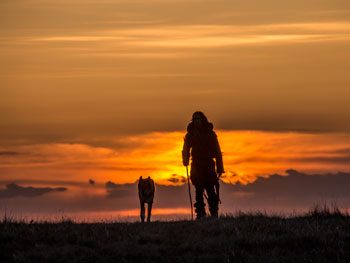
Europe, 20,000 years ago.
Cast: Leonor Varela, Natassia Malthe, Kodi Smit-McPhee
Director: Albert Hughes
Genre: Action, Drama
Running Time: 96 minutes
Synopsis: An epic adventure set in the last Ice Age, Alpha tells a fascinating, visually stunning story that shines a light on the origins of man's best friend. While on his first hunt with his tribe's most elite group, a young man is injured and must learn to survive alone in the wilderness. Reluctantly taming a lone wolf abandoned by its pack, the pair learn to rely on each other and become unlikely allies, enduring countless dangers and overwhelming odds in order to find their way home before winter arrives.
In a harsh landscape, when the future is uncertain, the bonds we make become our most important.
When language is a barrier, the actions we take reveal all.
And when the early peoples of the earth struggled twenty thousand years ago to overcome obstacles both long-term (a persistent Ice Age) and immediate (survival of the fittest), a historic relationship between enemies was forged. It forever changed the world, creating an enduring poignancy and lasting affection that reflects our shared humanity to this day. That special connection, between a boy and a wolf, is the stirring saga that is Alpha.
Seventeen-year-old Keda (Kodi Smit-McPhee, "Let Me In," "X-Men: The Apocalypse") is a Solutrean, part of a creative, resourceful Cro-Magnon tribe living in the area we know as southern France and Spain at the end of the last Ice Age, when most of Europe was uninhabitable, covered in ice two miles deep. Glacial winds blew. Winters were brutal and lasted nine months. Dangerous predators roamed the vast, unpopulated landscapes in search of food.
The isolation was extreme, and bonds of family and community were essential for survival. Keda leaves the safety of his village for the first time, accompanied by his father Tau (Jóhannes Haukur Jóhannesson, "Game of Thrones," "Noah") and other members of the tribe, to embark on the annual bison hunt, the success of which is essential if they are to have enough food for the winter. Keda is not yet up to the task, however, and his fear leads to him being injured and left for dead in a wilderness many miles from home. The impediments to Keda finding his way back to the village are numerous: starvation, illness, bone-chilling winter conditions, and, of course, predators.
At his most vulnerable, Keda is attacked by a pack of wolves. In his defense, he seriously wounds the Alpha wolf, which the distraught pack abandons. But instead of killing it, Keda carries the wolf to a cave where they take shelter. He cautiously heals the wolf's wound, and in his isolation comes to depend on the creature's risky, unpredictable companionship. Over time, mutual suspicion gives way to tolerance, and finally a lasting, affirming trust. They become reliant on each other to survive: hunting, eating, resting, even playing together. As Keda's momentous journey back to his tribe strengthens each of these wounded souls, they become each other's rescuer, family, and salvation.
A universal tale of discovery and friendship, marked by authenticity, richness of emotion, and stunning visuals, this is Alpha.
Alpha
Release Date: September 27th, 2018
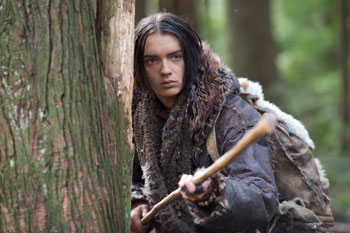 About The Production
About The Production
Both a rip-roaring adventure and a heartwarming story of mankind discovering man's best friend, Alpha evolved when a quest for a story that could transcend language barriers morphed into an idea to memorably dramatize the domestication of the wolf by early humans. Over many years, as a script was developed, and extensive research shone light on a rarely recreated time in history, a universal tale of family, struggle, and companionship took shape – just one that was set 20,000 years ago.
The world looked different then, but still held a recognisable majesty and starkness. Men and women were Cro-Magnon, but not the grunting figures so often portrayed in popular culture – their tool-making was sophisticated, creativity was essential, and tribes were like families, with their own complex hierarchies. Using this setting, and an old-fashioned story of survival and renewal, screenwriter Daniele Sebastian Wiedenhaupt and director Albert Hughes -- who had first envisioned the story of a wide-reaching boy-and-humanity's-first-dog -- hashed out a screenplay over Skype calls between Los Angeles, where Wiedenhaupt lived, and Hughes' home base of Prague. The wonders of modern technology, in other words, were utilised to bring a lost world to propulsive, understandable life for today's audiences.
Says Wiedenhaupt, "We wanted to tell the most universal story we possibly could, a story that was personal to everyone around the world who could watch it, so we went all the way back to this culture, which was incredible. The more we researched and the more we learned, we realized we had a rich tapestry to draw on."
Known for his detailed preparation, Hughes had already done a lot of research by the time he approached Wiedenhaupt. He then reached out to Dr. Jill Cook, a Senior Curator in the pre-history department at the British Museum in London (who is the Technical Consultant on the picture). She specializes in material between 40,000 and 10,000 years old. "I was quite enchanted by this idea," says Dr. Cook, "I thought the first moments when wolves begin to find friendship with human beings and begin to integrate into human societies and become domestic dogs, was such a nice place to set the story."
From Dr. Cook, Hughes took in the archaeological evidence that underscored the period, and which revealed how the Solutreans lived, from the weapons they used, to the techniques that gave them fire and allowed them to carve meat, clean skins, and make clothes, to the ways they ornamented themselves. Accuracy was paramount, although the requirements of drama meant rules needed to be bent. Even then, however, historical truths were applied: though early humans of the time were more likely to live in caves or on cliff over-hangs, Hughes' preference for filming with free-standing structures led the production to create round dwellings made with mammoth parts that were based on an older form of house known in central Europe, Russia, and the Ukraine.
Ultimately, believes Dr. Cook, this kind of imaginative storytelling allows today's moviegoing audience to encounter an invigorating view of real history, and see the past come alive. "I don't mind those compromises," she says, "because what the film will give us is a story which presents early modern man, not as ridiculous cavemen, with no emotions and bad habits, but as people like ourselves, rising to the challenge, thinking about problems, feeling emotions, love, fear and sorrow. It gives the general public a living view of what life in the Ice Age might have been like. I can carry on doing my forensic work and writing papers that few people will see, but this kind of story will draw in the general public, and hopefully give them lots of interest in the Museum as well!"
Alpha became a filmmaking reality when Hughes took the project to Jeff Robinov at the newly created Studio 8. Robinov, who'd been President of the Warner Bros. Picture Group, had started Studio 8 with the goal of making filmmaker-driven movies that could play around the world. Formerly Hughes's agent, Robinov had last worked with the director on "The Book of Eli," and when he got his first glance at the screenplay for Alpha, saw its potential immediately as a story to enchant young and old.
"He immediately fell in love with it and bought it," says producer Andrew Rona, who had also collaborated on "The Book of Eli." "It was as quick as that," He said, "I want to make this and it's going to be my first movie at Studio 8." True to his word, that's what happened."
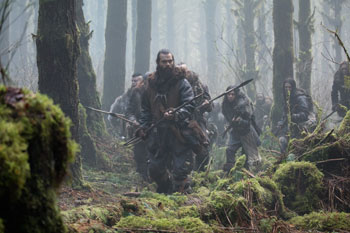 Alpha: Animal Instincts
Alpha: Animal Instincts
Central to moving Alpha forward, long before actors could be cast was figuring out how to portray the animals, and particularly Alpha the wolf that Keda befriends on his arduous journey home. The filmmakers understood that substantial visual effects would be necessary to convey the world of the Solutreans, and the particulars of Keda's and the wolf's burgeoning companionship. But Hughes wanted to film as much as possible in live, real terms, with genuine animals and on actual locations. The emotional weight of the movie's central relationship depended on it.
As soon as the project found a home at Studio 8, head animal trainer Mark Forbes from California-based Birds & Animals Unlimited joined the team to research their options. "There is a huge section of the movie with just the wolf and the boy on a journey," said Forbes, "That was going to be incredibly difficult to do with a wolf. They are known to be skittish, easily scared and difficult to train, so we did a huge search all over the globe. We ended up with the Czech wolf dog, which is the closest-looking and the most trainable."
Wolf dogs were created by the Czech army in the 1950s and are a cross between a German Shepherd and a Carpathian wolf. The breed isn't common, but it is recognised in Europe and is a show category.
Forbes hit the jackpot when in France he found five-year-old Chuck, a show dog who was also used for breeding. "They'd put him in the car and take him to the dog show," says Forbes, "so he'd become socialized, which was great for us, because meant we were starting far above zero." The other wolf dogs in the pack came from Spain and the Orkney Islands in Scotland.
"Wolves aren't really what people think they are," says Forbes. "They're not a predator in their own right. They're a pack animal. On their own they can be very afraid. The biggest hurdle to overcome with a wolf, even when they are only part-wolf, is to get them over any fear they have: the set, new people, new situations. Another challenge is that they don't have a dog's desire to please you. We are fortunate with Chuck in that he has the wolf look and a little more of the dog behavior. He does want to please me."
Forbes spent four months training Chuck. "After about three weeks, almost overnight, he suddenly knew what treats were," says Forbes. "He knew that he was learning something, and he wasn't nearly as afraid of us. From that moment on, he learned and grew in leaps and bounds, beyond anything I thought we'd be able to get a wolf dog to do."
Forbes introduced Chuck to Kodi Smit-McPhee"cast as Keda - early in the process, so that Chuck would get used to Smit-McPhee and lose his fear of him. The next stage was to get Chuck interested in the actor. Through a myriad of sessions, they developed a food history and Chuck would begin to think, "Kodi might have a treat for me!"
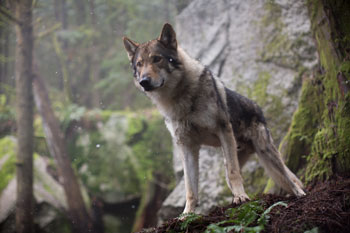 "Kodi trained with Chuck for many weeks," says producer Andrew Rona, "He would go out to Mark's facility and work on basic principles with him. They had to really build a relationship, a bond. If that didn't work we had no movie, like a romance where the male and female leads don't like each other." Hughes shot an old-fashioned chemistry test with them, with Smit-McPhee in costume out in the desert. "It was quite amazing," says Rona. "It was really the moment when we knew we were doing the movie, that we were going to be able to make it work."
"Kodi trained with Chuck for many weeks," says producer Andrew Rona, "He would go out to Mark's facility and work on basic principles with him. They had to really build a relationship, a bond. If that didn't work we had no movie, like a romance where the male and female leads don't like each other." Hughes shot an old-fashioned chemistry test with them, with Smit-McPhee in costume out in the desert. "It was quite amazing," says Rona. "It was really the moment when we knew we were doing the movie, that we were going to be able to make it work." Rona recalls meeting Chuck for the first time. "Albert and I went out to the Birds & Animals Unlimited facility in California. It was amazing experience to meet essentially the star of our movie. He was completely skittish and untrusting of us. He wanted nothing to do with us. Over time, being around us and being on set and working with all the actors and acclimating himself to the environments, he's become part of the family. He sees us and he's sort of, 'Hey, there are those guys who are making a movie. Let's go.' Chuck's become quite a star. Everyone loves him. Everyone wants to be with him. It's like watching a young actor who's grown into a much more mature and confident person. He will do anything Mark wants him to, which is an amazing accomplishment."
Hughes concurs: "Without Mark Forbes and Chuck, there wouldn't be a film."
For Forbes, one of the challenges was keeping the relationship somewhat realistic. "You didn't want it to become too dog-like, because a wolf wouldn't do that. A wolf is used to living in a pack, and hunting is ten times more effective in a pack than it ever would be alone. For that reason I believed there was some truth in the idea that to survive, this wolf might create a symbiotic relationship with this human. It's really what the story's about. Both of them realise they have a much better chance of surviving together, so we tried to keep a little bit of tension, an aloofness in some scenes."
Forbes continues, "It stays real to what could have happened, and at the end there's this incredible bond between them and leads to the creation of this relationship we now enjoy the world over with dogs. I thought it was a great tribute to that story and how it may have happened."
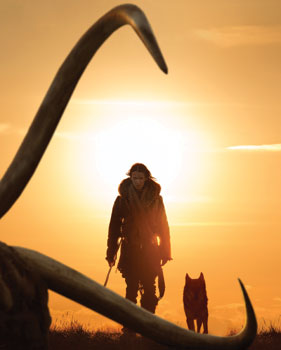 Alpha: The Human Element
Alpha: The Human Element Studio 8's Jeff Robinov believed that filling the human roles with established movie stars would distract the audience and take them out of the story, and out of the world the movie needed to make vividly real. This meant that the filmmakers were able to bring together a truly international cast, a tribe of talented actors for whom English was not necessarily the first language.
The casting of Keda was of vital importance, because for a large part of the movie, he is the only human character onscreen, and one-half of a carefully knit relationship that needed to cover a lot of emotional ground: from ingrained distrust to hard-won friendship. "We were lucky to have Sarah Halley Finn, who is an amazing casting director," says Rona. "She basically picked Kodi right off the bat. He was one of the few people we met. It was almost kismet."
Kodi Smit-McPhee's measure of a script, when he reads it for the first time, is where it hits him in his heart and his emotions. "I've been doing a lot of modern tales and I've been waiting for something that deals with earth and mother nature" says the Australian actor. SmitMcPhee, who at twenty is already a veteran film actor, has been making his own journey from boyhood to manhood onscreen. "I always find a pattern with the characters I play," he says. "They are quite vulnerable, coming of age, and eventually transformed at the end, but this has been the transformation on the biggest scale."
"When you see Kodi on the monitor," says actor Mercedes de la Zerda, who plays a fellow hunter, "you see the subtleties in his work and it blows you away. It's just him and a handful of words in two-thirds of the movie. To have found a talent who can communicate so much, just in body language and to have so much of an inner life happening without dialogue is a major accomplishment."
"Kodi is a deeply and naturally gifted actor," says Hughes. "His instincts are very mature, and he doesn't come from an intellectual place when he's acting. He comes from an emotional place. He comes from the character, so he's really exciting. I'd say he's leaps and bounds above a lot of guys his age. Then, when I see a close-up, I go 'God! This guy is really special.'"
To play Keda's father Tau, a man driven to teach his son the tools to be a fearless warrior/provider, but also fearful of what that kind of education means to the boy's survival, the filmmakers cast Icelandic actor Jóhannes Haukur Jóhannesson, in whom Hughes saw the vulnerability a father needs. "There's a toughness he can play," says Hughes, "but he had that heart that I really liked."
"Working with people from all over the world is always exciting," says Jóhannesson "On this film we have people from Australia, Iceland, Sweden, Poland, Belgium, Chile, Bolivia. We have Canadians, Americans. What's surprising about that is you sort of have this in your mind that people are different, but we really are not. All these people from different parts of the world, and they're all the same, basically. We're just people. So that's been an enjoyable learning experience."
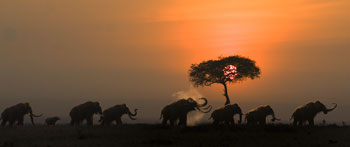 Alpha: New Words, Old World
Alpha: New Words, Old World The language of Alpha is another special dimension of the film. Some actors found themselves learning Cro-Magnon 101, while others had to rethink how to create their characters and communicate feelings without words.
"The script started out with very minor amounts of dialogue," says producer Andrew Rona, "and that was a conscious decision Albert made, because he wanted the film to play on an emotional level. That being said, we needed to create a language, the Cro-Magnon language. There's no record of what that language was. There's no way of knowing. The only things we know about them are from fossils and bone fragments."
Rona continues, "We went to a place called the Language Creation Society, the LCS. This is a group of people who actually create languages. They've created languages for "Game of Thrones," Na'vi for "Avatar," and Kryptonian for "Superman." The latter was created by Christine Schreyer, a PhD and Associate Professor of Anthropology, and she happens to be based in Canada. We sent her the script and she rolled up her sleeves. She went all the way back to the very, very early languages. She really studied the very origin of language as we know it."
Schreyer (Language Consultant on the picture) acknowledges that the scholarship leaves a lot open for interpretation. "While most scholars agree that Cro-Magnons (or anatomically modern Homo Sapiens) had language in the Upper Paleolithic area," says Schreyer, "few have suggested what it might be like, as it's difficult to predict how languages have changed over such a lengthy period of time."
Schreyer studied three "proto" languages from close to this time period and geographical area. Proto languages are estimated reconstructions, based on current spoken language families. All three languages had similar sounds and she used them to create the sound system and sentence structure of Cro-Magnon.
One of them, Proto-Dene-Caucasian, dates back to 20,000 to 25,000 BCE, the time of the last Ice Age, and was found in refuge areas on what is considered to be the North American side of the Glacial Maximum.
After three and a half months of work, Schreyer had created a functioning language, and a vocabulary of about fifteen hundred words. She prepared a Cro-Magnon 101 document for the cast, with a sound chart, based on the international phonetic alphabet, descriptions of how the sounds were pronounced, and audio recordings. She followed up with tutorials on Skype.
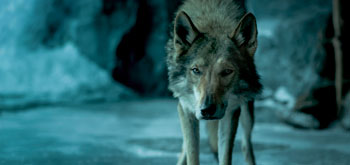 "I gave them the English line with the Cro-Magnon language underneath," she says. "I'd also have the meaning of each word, because the word order is different as well. It's subject, object, verb. You need to know what each word is, in order to emphasize them properly."
"I gave them the English line with the Cro-Magnon language underneath," she says. "I'd also have the meaning of each word, because the word order is different as well. It's subject, object, verb. You need to know what each word is, in order to emphasize them properly." It was the unusual fact that a language was being created for the project that made Swedish actor Jens Hultén want to be part of it. As the Lion Tribe's leader, Jens Hultén speaks a Cro-Magnon dialect created by Schreyer for the film. "It wasn't easy to learn in the beginning," he says. "There was nothing to relate to. When I'm talking now, I relate to modern body language, nodding of the head and so on. Maybe they didn't. The biggest challenge was not to fall into the poses of modern life, such as standing with your hands on your hips, or leaning against a tree. You had to find another body language, take away all the unnecessary movements that we're used to. Then when you move, you express something."
Smit-McPhee's lines as Keda were peppered throughout the screenplay, but Jóhannesson, as Keda's father, found himself with the lion's share of the language. "Tau has quite a lot of lines because he's always teaching," says Jóhannesson. Fortunately, the actor is also a resident artist at Iceland's National Theatre and speaks four languages, so he was as well prepared as anyone could be. He also knew some of the sounds English speakers find tricky, because they happen to be in Danish and Icelandic.
"Christine worked with us," says Jóhannesson. "It was all written down phonetically. She taught us to read the phonetic alphabet. You received all the text written phonetically, highlighted where the emphasis was supposed to be and that required a lot of time, a lot, a lot of time. I tried initially to just learn it phonetically, learning the sounds, but that proved to be quite impossible because there was so much. Because she'd made a real language, it had rules and it made sense, so I just had to go for learning the words. Then you start to pick up, this word means 'will.' This means 'you.' This means 'me.' I spent so many hours, but it was so great when you finally learned them."
Regarding the language, Jóhannesson describes a momentous day on set when he watched Smit-McPhee filming a scene Jóhannesson wasn't in. "He was speaking, and I understood what he was saying!" says the actor excitedly. "It's quite satisfying after the fact, but initially when I got the task of learning all these lines, it was quite overwhelming. I was quite scared. Eventually I reached a comfortable place with it. Usually learning the lines is such a mundane, first thing you do. You learn the lines and then you start to work on how the scene is and how you're going to deliver them. Learning the lines is supposed to be to just get that out of the way but getting them out of the way proved to be quite a task on this one."
Alpha: Cro-Magnon Camp
The language was only part of the cast's learning curve. In the week before filming, they took part in a Solutrean boot camp, led by Karl Lee (Flint Knapper Advisor to the picture), a British archeologist specializing in pre-historic bushcraft and the creation of tools and weapons, the way early humans created them 20,000 years ago. He is an expert Flint Knapper, someone who replicates the different tool types from the Paleolithic to the Bronze age.
Lee made stone tools and spear heads for the production and showed them how it was done. Says Lee, "This is my period. I specialize in the Upper Paleolithic, after the Stone Age. Once we get to the Solutreans we've got a very sophisticated culture. You've only got to look at the tools they're producing to see that. Flint Knappers now struggle to make a Solutrean spearhead. They're incredibly difficult to make."
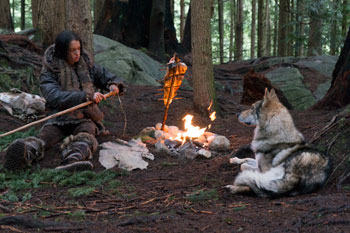 Lee had never worked with actors before and didn't know what to expect. "I thought they'd be scared of getting their nails dirty," he says, "but they rolled their sleeves up and really got into it. We did friction fire lighting. They made spears and spear-heads and they practiced throwing their spears as well. Kodi is a natural Flint Knapper. If he ever gives up film, I'd love to have him as an apprentice! He did a fantastic job. He's very patient and methodical."
Lee had never worked with actors before and didn't know what to expect. "I thought they'd be scared of getting their nails dirty," he says, "but they rolled their sleeves up and really got into it. We did friction fire lighting. They made spears and spear-heads and they practiced throwing their spears as well. Kodi is a natural Flint Knapper. If he ever gives up film, I'd love to have him as an apprentice! He did a fantastic job. He's very patient and methodical." Says Jóhannes Haukur Jóhannesson, "The initial idea was to have us stay out in the wilderness for a night or two and just survive on our own, which I would never chose to do, but it's nice to be pushed into that. You say, well fine, but then of course the producers start to think, 'Well what if one of the actors gets sick and he can't film.' So we slept indoors instead! The boot camp made us realize how much they had to go through to have the essentials of everyday life."
The cast had only just met at the time of the boot camp, and in addition to the skills learned, it was helpful as part of the bonding process. Says Marcin Kowalczyk, who plays Tau's second-in-command Sigma, "I really appreciated having the time to prepare the role, especially as it helped in the process of building the tribe, being together and building the relationships necessary to act together. It's good to have real relationships as a group. It's much more comfortable to work, when you trust each other."
Alpha: A Look Into The Past
Having assembled a diverse cast from all over the world, the filmmakers then had to work out how to make them look as if they all came from the same place. Hughes worked with the hair and make-up teams on everything from individual looks to the right skin tones.
Costume designer Sharen Davis already knew Hughes from working on "The Book of Eli." "Albert had the best research book ever," she says, "and he'd done some illustrations. They were modernish, but with the right feel. Then he gave members of the cast and crew films and books about the Solutreans to study in preparation for their roles. We were quite shocked at how advanced these people were. They had needles. They sewed their clothes and they really kept warm."
Dr. Jill Cook provided the costume department with all her research, which proved invaluable. Says Davis, "It was incredible. For me, the most inspiring thing she said was, 'If I don't have proof of its existing, then who knows if it was there, so go for it.' She had proof of the sewing, proof that they wore the fur to their body and the skins on the outside. They would garnish themselves heavily with jewelry, and jewelry was used in trade. They really took care of their hair. They painted their face. They were quite advanced. They made their own moccasins. It's a lot of work because we had to hand sew everything."
For Dr. Cook, the opportunity to watch the props being made by Davis's talented crew was a fascinating experience – the ability of movies to simulate a world long gone. "To discuss the use of weapons, to see the fantastic costumes, to see wolverine skins and reindeer skins being made into extraordinary suits, to see the ideas for the female Shaman and all of her jewelry, the little bags and pouches they'd made for hunters to carry their fire making equipment and their needle and thread. it all brought to life so many things that I've only ever known as drawings in books."
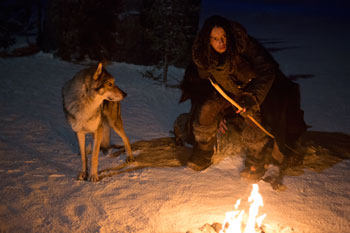 Says Davis, "We had almost thirty people in the costume shop. We had a professional moccasin maker, who made beautiful handmade moccasins. She had a crew of three. Then we had a jewelry maker with a crew of five. Then we had three cutter/fitters who cut the hides and the fur. I would do a drawing and I'd pick a hide like deer and mix it with bison. Then we'd decide which stitch we wanted and how we wanted the hood and if we wanted beads on it, or natural stones. It was quite a process. The cast was quite large."
Says Davis, "We had almost thirty people in the costume shop. We had a professional moccasin maker, who made beautiful handmade moccasins. She had a crew of three. Then we had a jewelry maker with a crew of five. Then we had three cutter/fitters who cut the hides and the fur. I would do a drawing and I'd pick a hide like deer and mix it with bison. Then we'd decide which stitch we wanted and how we wanted the hood and if we wanted beads on it, or natural stones. It was quite a process. The cast was quite large." When it came to hides and fur, Davis used a lot of fake fur, because, she says, "it actually it holds up better. The inside of the clothes is all fake and it reinforces the real hides, because once the animal has passed away, the fur is not that strong any more. There is nothing giving it oil. They are all treated, but they do start shedding. I'm a PETA girl, so I really like the fake fur. We had a distressing department and they really made the fake fur look like real fur, like bison or musk-ox."
After so much work recreating their clothing, Davis came to a realistic guess about this ancient people. "I think the Solutreans' hands were probably really callused," she says. "I think sewing was part of their daily regimen, and they took a lot of pride because they did two stitches on every seam. They sealed it with the second one to make sure they didn't get cold."
Another challenge, says Davis, was finding the individuality in each tribe member's wear. Says Davis, "It's all skins and hides, but there was really a limited amount. Which one makes you look like the tribal leader? And what would the younger guys wear? You had to make those characters work. You have to know when you see that guy, he's the warrior. And then we had three tribes and I had to make them look different and yet somewhat similar because they are friends."
The costumes were incredibly heavy, some weighing over forty pounds. It made them tiring to wear for the actors. Although the clothing kept the cast warm in the February cold, the costumes became even heavier in the Vancouver rain, and during some unusually hot days in Alberta, it was like walking around in a sauna.
"The costumes help so much," says Mercedes de la Zerda, who plays one of the hunters, Nu. "As soon as you put them on, you hold yourself differently. It's a real gift every morning. As I'm getting dressed, I sometimes take five minutes and really look at each piece they have created for you, the belts with the animal teeth, the necklaces with very specific beads and stones. I have one that has a piece of jawbone on it. I think if Nu, my character, created this necklace, why would she pick that bead, that stone. Why the jawbone? What was that hunt like?"
The most splendid costume was that of the Shaman woman, clearly differentiated by her headdress and her cape made of feathers. "The wardrobe was so grounding into that character," says Chilean actress Leonor Varela, who played her. "The head piece I'm wearing is out of this world and the robes. When I tried on this wardrobe, which is bar none the most amazing thing I've ever worn, I felt as if half of the work was done for me. We had a scene at the village, where I bless the hunters. It was really magical, because all I had to do was exist in that place."
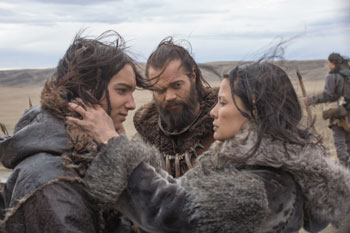 Alpha: Ancient Places, Real Locations, Movie Magic
Alpha: Ancient Places, Real Locations, Movie Magic Filming on Alpha took place in Canada, in and around Vancouver. B.C., and in the prairies and Badlands of southern Alberta, with its endless skies and sunsets so magnificent, they bordered on the unreal. Filming also took place in Los Angeles and Apple Valley, California along with the far east side of Iceland.
Hughes' films have a reputation for strong imagery, and Alpha presented the opportunity to broaden his cinematographic palette farther than ever before. In preparation, Hughes created a four hundred-page shot list, and to accompany him on this fantastic visual journey, he chose a young Austrian director of photography, Martin Gschlacht, whose work he'd seen at Cameraimage, a film festival dedicated to cinematography. Gschlacht, who won a European Film Award in 2015, agreed to work on the project before he'd even read the screenplay. Used to Austrian winters, he was never deterred by the unpredictable weather.
"You have to make nature, and especially weather, always your friend," says Gschlacht of shooting on location. "There is no bad weather. There is only the wrong in dealing with it. I think you need to be very precise in thinking about light, thinking about the time of day, finding the right angle for a whole shooting day, and being very smart about which scene to shoot and when. But the biggest challenge is to make sure you find the right landscape and light, and make that look beautiful. That's why you go there early with all your tools to measure it. Thinking about faces, people, the background … that's what you have to do. It's a wonderful challenge."
Gschlacht describes what he had to work with in Alpha as "an enormous visual script. There's almost no dialogue. There's a lot of atmospheres, landscapes, and knowing Albert's idea of how important it is for him to work with light and creating special atmospheres, I thought of this as a fantastic visual journey."
For Hughes, nature became the third main character in the movie. The Solutrean village was built on a promontory overlooking the Bow River, with steep grass slopes leading down to the river, in a deep canyon below. It was a beautiful, memorable setting in its own right, and was further enhanced by visual effects with images of the mountains of Patagonia.
The seven village huts, built in Vancouver using hides and mammoth bones, were reassembled there in inclement winter weather. The mammoth bones were created from a 3D print. The set decorating team created, which were filled with silica, which is how hundreds of these ancient bones were constructed.
When it came to the Shaman's hut, Leonor Varela was entranced, describing her character's abode this way: "There was always a fire in the center to keep the hut warm and provide light. There's an opening in the top for the smoke to go out. It's made with skins and is constructed architecturally with tusks and bones. They're held together by ropes. Inside you see an array of things from trinkets to sage burning pots, to stones where they would sit and skins where they would sleep. There are drawings on stretched out hide, which illustrate their connection to nature and hunting."
The village location at night time was a magical place. As the camp fire burned brightly and the flames leapt high, the villagers sat on stones surrounding the circular fire pit. It was here that the Shaman woman blessed the hunters before their journey. "Albert said to me, 'Do you want to chant?'" says Varela. "I said, 'Sure, I'll chant. I'll see what I can come up with.' Albert gave me some music to listen to just before the scene and I created this completely guttural sound that came out of nowhere. I have no idea where that came from. It was completely improvised and I really appreciate Albert for that moment." When other cast members spoke of moments which felt real to them, it was also in and round this village setting.
Alpha also filmed at Dinosaur Park, a UNESCO World Heritage site, where 150 complete dinosaur skeletons have been found from the late cretaceous period, seventy-five million years ago. The geology and the colors of Dinosaur Park, with its hoodoos - pinnacles of weathered rock - are so unusual, they will very likely be mistaken for a visual effect. "We had unprecedented access to a place that looks as if it is untouched by time," says producer Andrew Rona. "It's breathtaking. Everywhere you go, you might be stepping on a fossil, something that's been there for millions of years."
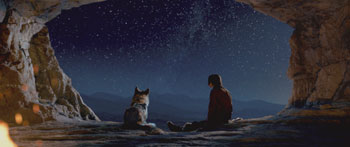 The locations department laid rubber pathways, literally to minimize the footprint. The production got as much shooting completed as they could before rainfall, followed by an April snowfall at Dinosaur Park, sadly cut filming short. In Alberta, the production also filmed on Siksita Nation (Blackfoot) land and in Drumheller. Each location contributed an important component to the Ice Age landscape.
The locations department laid rubber pathways, literally to minimize the footprint. The production got as much shooting completed as they could before rainfall, followed by an April snowfall at Dinosaur Park, sadly cut filming short. In Alberta, the production also filmed on Siksita Nation (Blackfoot) land and in Drumheller. Each location contributed an important component to the Ice Age landscape. In Vancouver, large areas of cleared ground, in a previously industrial area, were used as open-air backlots. Huge blue screens and expanses of fake snow, and on one occasion a cliffside, sat alongside busy urban streets, in complete contrast to the pristine environment of the story. "We made a huge number of sets out of two spaces really," says set decorator Terry Lewis, "just by reconfiguring and moving items, elements and objects around to give very untouched snow fields and in other situations, very tight rock corridors for our characters to run through and for the animals to interact with characters. Each and every night when the shooting crew said, 'Thank you, good night,' construction, the set decoration team, special effects, the greens, leapt into action and prepared the set for the next day."
Says production designer John Willett, "We'd take everything that was there and rearrange it and then add trees to make it into a different place."
Albert Hughes recognizes the particular challenges in historic recreation that Alpha represents. "It's very difficult to replicate the Ice Age nowadays," says Hughes. "It's a cross between Siberia, Iceland, the North Pole, and maybe New Zealand. There's not one place in the world that looks like what the Ice Age looked like, so we had to create it sometimes on the backlot in Vancouver, sometimes in Alberta on real locations. You have to put the puzzle together to make the look of the movie. What was special about Alberta were the vast plains that looked like open tundra, which is what Europe looked like back then, but it is definitely more of a hyper real look at the Ice Age."
With the help of visual effects supervisor Jeffrey A. Okun, Alpha could also add skies both filmed and created. "Each one is going to be a character," says Okun, "to help set the emotional underpinnings of the film."
Producer Andrew Rona notes that Alpha is a shining example of how technology and the real world combine to make a thrilling movie experience. "We have visual effects, where you won't know they're there, and we have real things that you might look at and say, that's a visual effect," says Rona. "We shot beautiful locations in Alberta, but there's a whole other layer that will be added to that in post-production. We have an Iceland unit, an Africa unit. The film will be an amalgamation of all these different places. We couldn't have done this film without technology and we couldn't have done it without being out in the real elements."
Ultimately, everyone associated with Alpha came to an understanding that for all the hard work involved in bringing an ancient world to life, the thought that audiences would gather in a theater and be transported by a boy and his wolf made the entire experience worthwhile. "Our goal was escapism," says Hughes. "It's almost like the old campfire stories. The great storytellers told stories around a campfire, and it was a communal experience. That's why people go to the movies. You hear laughter together, people cry together, you're in a room with total strangers and you're experiencing the same thing."
And in Alpha, that's the story of an unusual friendship that altered history, and redefined strength for two living beings reared to assume strength meant aggression. "What they took as weakness was a major strength," says Hughes of the movie's young warrior Keda. "Had he not had the heart for this one animal, that animal would not have helped him survive. He needed that animal, and that animal needed him, and so they went on this journey together."
Producer Andrew Rona hopes audiences have not just a good time, but a thoughtprovoking one. "I think it's going to be a thrill ride for them, but it's also going to be something they learn something from. It's really amazing when you can make a film that is both exciting and entertaining, but also makes you think about where you come from, who you are, how we're all connected, and that it's one world. It's a piece of entertainment, but there are things underneath it that I think people will take away from it."
Alpha
Release Date: September 27th, 2018
MORE



